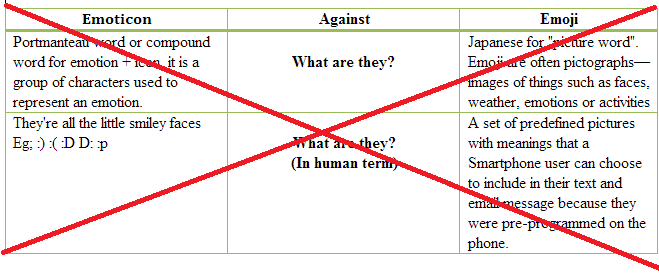in the year of 1999, the number of cellphone users in Japan had increased when it came to the use of picture message as a way to communicate. the problem was, the size of a single picture message is times bigger than the text message. at that time, the mobile operators were already struggling to provide and support the needs of 80 mil. users as the technology's growing rapidly.
the engineers were told to fix this problem and they came out with a solution,named Emoji.
Emoji was born in a Japanese research facility.
a mobile hone provider in Japan, DoCoMo i-mode, became the first entity to allow users to add pictures of commonly used emoticons to their text message(s).
Basically, emoji is not all about the pictures that you add on to your text. I'd rather say emoji can be pictures, or codes
Impact
Users rejoiced at having emoticons in their text message(s) such that their existence had made the text message(s) became alive. In a time of text message(s) with up to 160 characters limits, while emoji being a character, it could go a long way.
Emoji is codes
Emoji (絵文字 or えもじ; Japanese pronunciation: [emodʑi]) are the ideograms or smileys used in Japanese electronic messages and webpages, whose use is spreading outside Japan. Originally meaning pictograph, the word emoji literally means "picture" (e) + "character" (moji). The characters are used much like ASCII emoticons or kaomoji, but a wider range is provided, and the icons are standardized and built into the handsets.
roughly translated, Emoji is a standardized icon with its meaning which commonly used by Japanese cellphone users (at that time) and widely spread all over the world
Emoji
|
Codes meant to be read and
transferred by computers, then decoded into predefined images users can see.
They are limited in number.
|
Emoticon
|
They are user created images from text so the possible
combinations is infinite.
|
What is Emoji..really?
Emoji is used to look likes emoticon does but they're slightly different.
Emoticon
|
Against
|
Emoji
|
Scott Fahlman used the first
emoticon ":-)" on Sep. 9, 1982.
|
Who invented it?
|
First introduced in DoCoMo I-mode, but since integrated into the mail
and web services of all mobile carriers in Japan
|
Adding a face to messages can project tone. Our brains are
good at recognizing humanistic qualities which can make make the messages
seem like 'more than words on a page'.
|
Problem solved?
|
Wireless
phone companies in Japan used the emoticon idea and made it easier for people
to use emoticons in messages, using Emoji. Enabled people to send elaborate
messages over text quickly, using pictures, without clogging up the wireless
data networks.
|
This wasn't really a
"need" for it except to be human. It was more of a 'want' that was
really easy to do.
|
Fill a need
|
Mobile operators are
under constant pressure to keep their networks running smoothly. Any
shortcuts that can be taken to limit bandwidth are strongly considered. Emoji
allowed pictures to be sent while decreasing message size.
|
Example
|
|
|
Unlimited. People think of new
ones every day.
|
How many are there?
|
Limited number..
Under 2000.
|
it's said that the emoji thingy had been revolutionized by Apple Inc.'s Steve Job meanwhile Computer users in east Asia developed a much more complex set of emoticons using ASCII for emoticon
cc-iemoji






No comments:
Post a Comment